Will a convicted felon win the presidential election? The answer’s contours are visible days after a jury found former President Donald Trump guilty in his hush-money trial. Both empirical metrics and political trends suggest his felonious status will help rather than harm Trump’s electoral prospects.
Post-Debate Polling: Joe Biden will be a one-term president. That is the inescapable conclusion following voters’ reaction to his disastrous June 27 debate performance. Whether Biden loses the election or is ousted as the Democrats’ candidate, he’s not likely to survive America’s worst-ever televised debate display.
Voters told our Democracy Institute/Express US poll that Trump out-debated Biden by 61 percent to 19 percent. By 67 percent to 33 percent, the SSRS/CNN poll found Trump turned in the better debate performance. A Leger/New York Post poll found Trump won the debate by 49 percent to 17 percent over Biden.
Biden not only sounded terrible to voters, he looked even worse. Allegations about Biden’s physical and mental impairments were confirmed on live television.When he was not speaking, the camera portrayed a fragile, elderly man, mouth agape, sporting a blank, unblinking stare. When he spoke, his raspy voice mumbled, often incoherently, throughout his statements.
“I really don’t know what he [Biden] said at the end of that sentence. I don’t think he knows what he said, either,” Trump quipped at a key moment, summing up Biden’s presentation and, crucially, voters’ responses to it.
Following the debate, Trump enjoys his largest lead this year over Biden in our Democracy Institute polling: 5 points head-to-head with Biden; and 7 points against the full field, including Robert F. Kennedy, Jr. The Leger/New York Post poll also found the debate resulted in a 7-point Trump lead, his largest lead in Leger’s polling to date. An Atlas Intel/CNN poll now has Trump up 5 points on Biden against a full field; Patriot Polling’s 4-point Trump lead versus a full field is double his lead in their previous poll.
Pro-Trump campaign ads blanket the airwaves with debate clips demonstrating the presidency is beyond Biden’s cognitive grasp. Meanwhile, the voters have spoken: reelection is beyond Biden’s reach.
Post-Conviction Polling: The May 31 Democracy Institute/Express poll of 500 likely voters, conducted immediately after the verdict, found Trump’s conviction made 26 percent more likely to vote for him, while 20 percent were now less likely to do so. The conviction made no difference to 56 percent of voters.
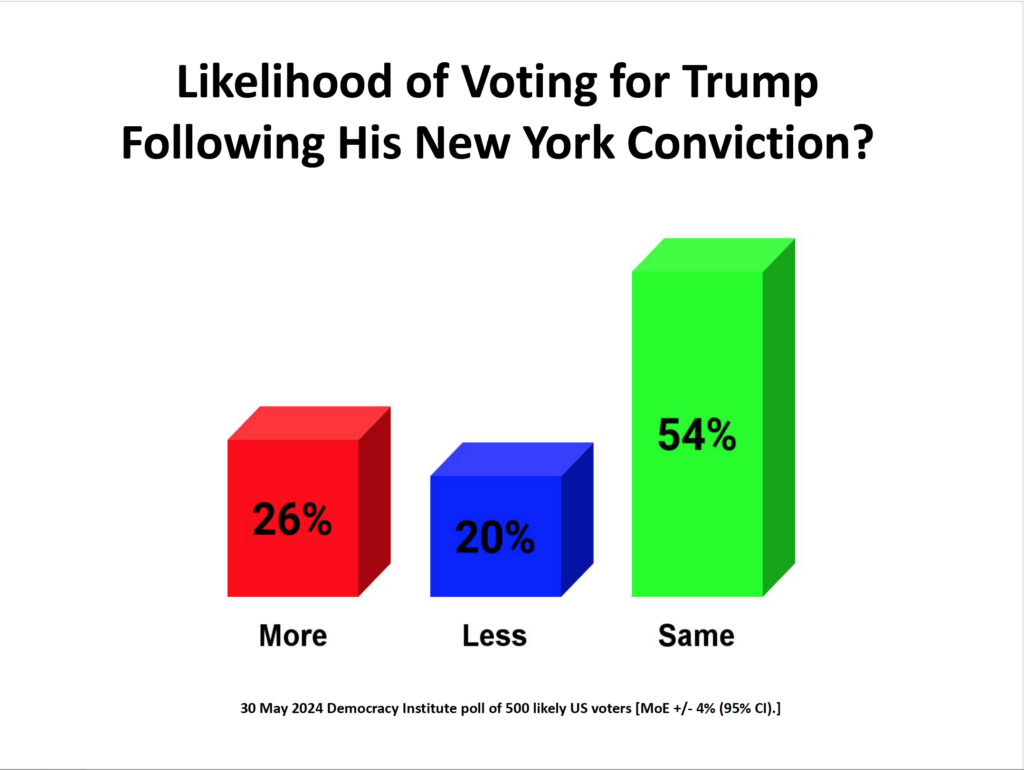
These results are consistent with a Democracy Institute/Express poll conducted seven months earlier. In that poll, 22 percent were more likely and 18 percent less likely to vote for Trump should he be convicted in any of the cases threatening him. None of these findings are surprising given that the October 2023 poll found a sizeable majority (58 percent) thought Trump was the victim of a legal witch hunt.
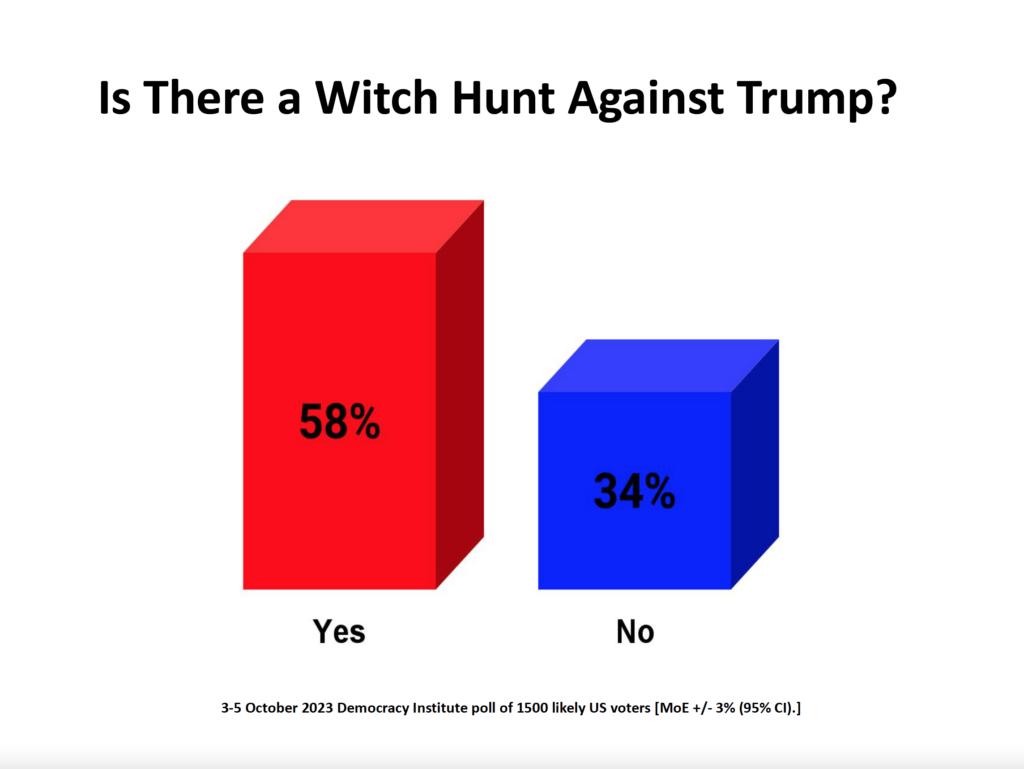
A pre- and post-verdict Reuters/Ipsos poll of 2,135 registered voters found a plurality (48 percent) agreed with the statement that Trump’s New York indictment was politically motivated. Forty-four percent disagreed. While Democrats overwhelmingly disagreed (79 percent) and Republicans overwhelming agreed (83 percent) with the statement, more independents (47 percent) agreed than disagreed (40 percent).
Meanwhile, a May 31-June 1 ABC/Ipsos poll of 781 adults found 47 percent agreeing that the charges were politically motivated, while 38 percent did not agree. Pollster Frank Luntz’ post-verdict focus group found the majority think the case should have never been brought. Several focus group participants do not like Trump, but nevertheless think the case was a political hit job. In another positive signal for Trump, the ABC/Ipsos poll found Trump’s favorability rating rose two points from the previous poll three months ago.
A post-verdict Reuters/Ipsos poll found 15 percent of Republican voters want Trump to drop out of the presidential race in favor of a different Republican candidate. Yet, when a May 26 Leger poll asked Republicans whether they would have preferred a candidate other than Trump, one-third (33 percent) said yes. The same Leger poll found 58 percent of Democrats would have preferred a candidate other than Biden, which bodes ill for his campaign’s voter turnout program.
These results strongly suggest Trump’s conviction was the catalyst for a unifying rally-around-the-candidate effect that will aid the Trump campaign’s own voter turnout effort.
Popular vote and approval: To date, there is no empirical evidence that Trump’s heretofore small yet consistent lead in the national popular vote, as well in almost all the swing states, is in jeopardy.
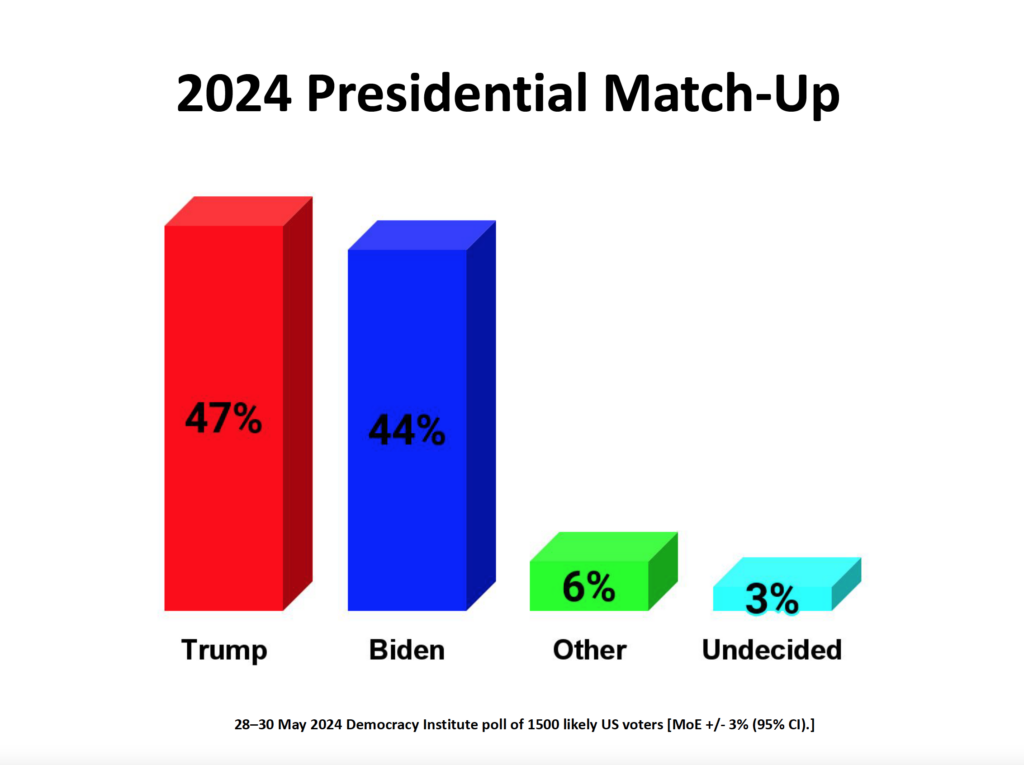
The 1,500 likely voter Democracy Institute/Express US poll taken May 28-30 had Trump maintaining a solid 3-point lead over Biden in a head-to-head matchup. In a multi-candidate field alongside independent and third party candidates, Trump’s lead over Biden extends to 4 points. The 500 voters polled on the evening following the verdict gave Trump a larger lead over Biden than did the 1,000 voters polled pre-verdict, both in the head-to-head and multi-candidate contests.
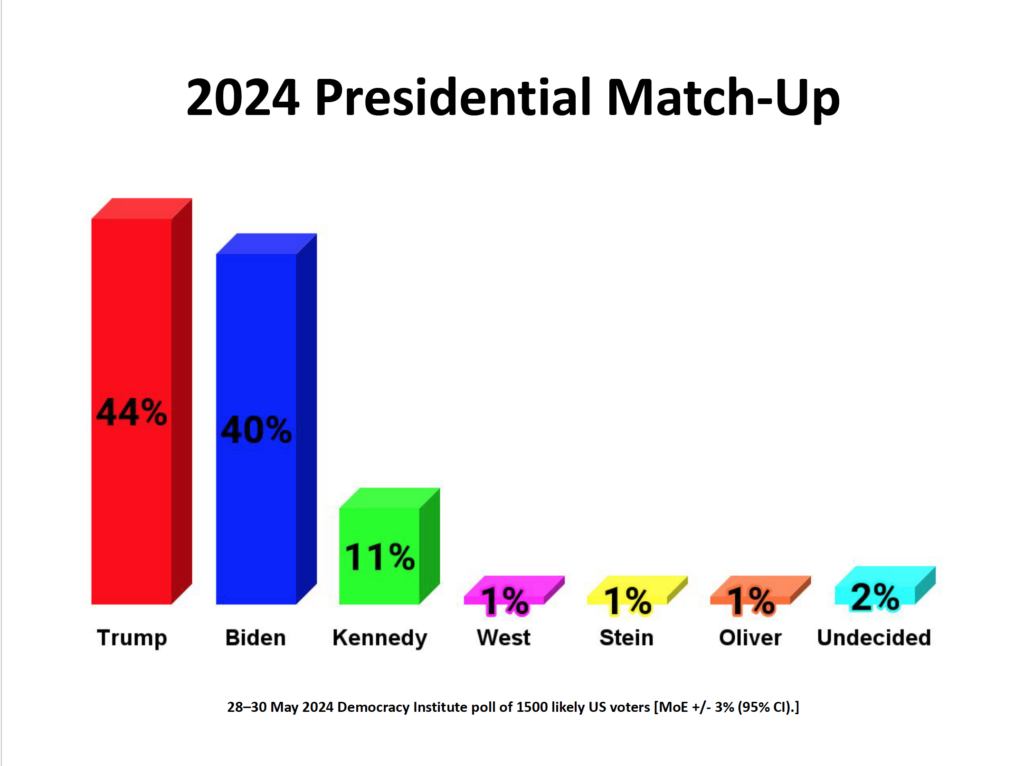
An I&I/TIPP pre- and post-verdict poll of 1,675 registered voters found Trump and Biden tied 41 percent to 41 percent, showing an improvement for Trump, who had trailed Biden 42 percent to 40 percent in the May 3 I&I/TIPP poll. In a multi-candidate contest, Trump and Biden remained tied at 38 percent each with Kennedy on 10 percent, Stein 2 percent, and West 1 percent. A May 31 to June 2 Morning Consult poll of 10,404 registered voters found Trump leading Biden 44 percent to 43 percent after Trump had trailed Biden by one point in Morning Consult’s May 31 poll.
One reason it will be difficult for Biden to consistently overtake Trump in post-verdict polling is the former’s poor approval ratings. Historically, no incumbent president with an approval rating below 45 percent has been reelected.
On June 4, RealClearPolitics’ poll aggregator pegged Biden’s average approval rating at 40 percent. The most recent Democracy Institute/Express poll found his approval rating to be 39 percent (Figure 6). A June 2 CIVIQS poll put Biden’s approval rating at 34 percent. According to CIVIQS, Biden’s approval ratings in the battleground states are uniformly dismal. For Biden to confound electoral precedent, his approval ratings must improve significantly, and quickly.
Swing states:Where the respective campaigns invest their finite resources, financial and human, as well as the candidates’ respective itineraries, already reveals a great deal about how the election is shaping up. Despite his guilty verdict, it remains clear that the Electoral College arithmetic favors Trump. His campaign remains on the front foot, expanding the Electoral College map in the hope of a blowout victory, while Biden’s campaign is playing defense in fear that squeezing out a narrow victory is the most it can achieve.
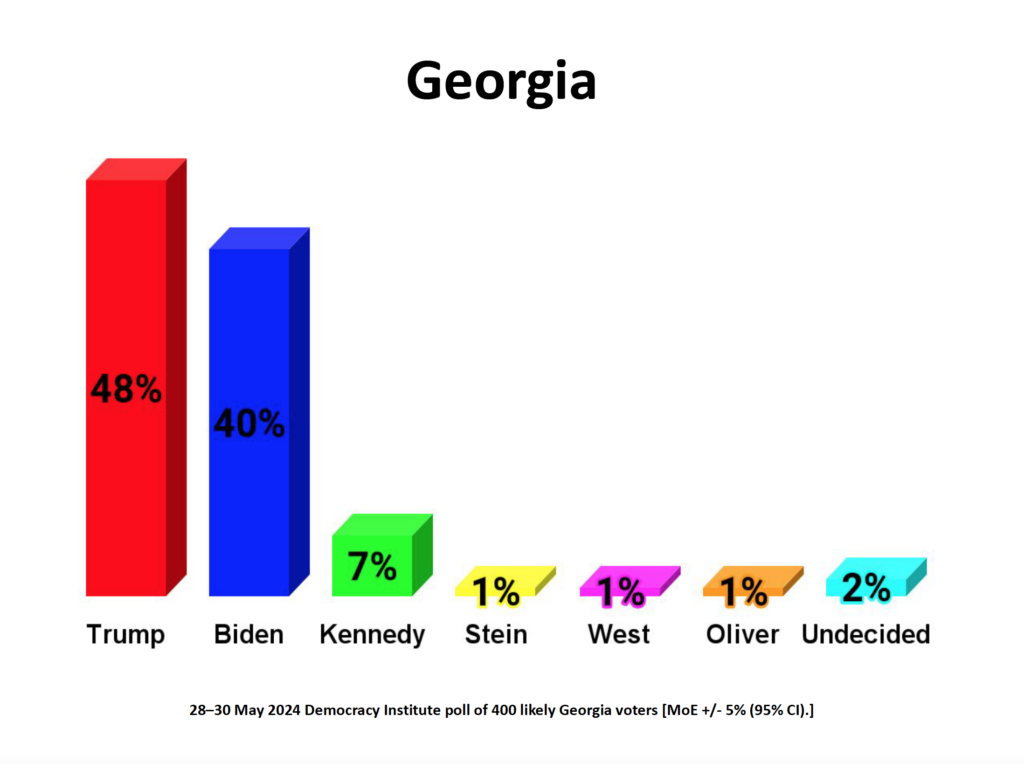
The Trump campaign is not only favored to flip Georgia, Arizona, and Nevada, but it is extremely competitive in Pennsylvania, Michigan, and Wisconsin. With the exception of Nevada, Biden won each state in 2020 by the narrowest of margins.
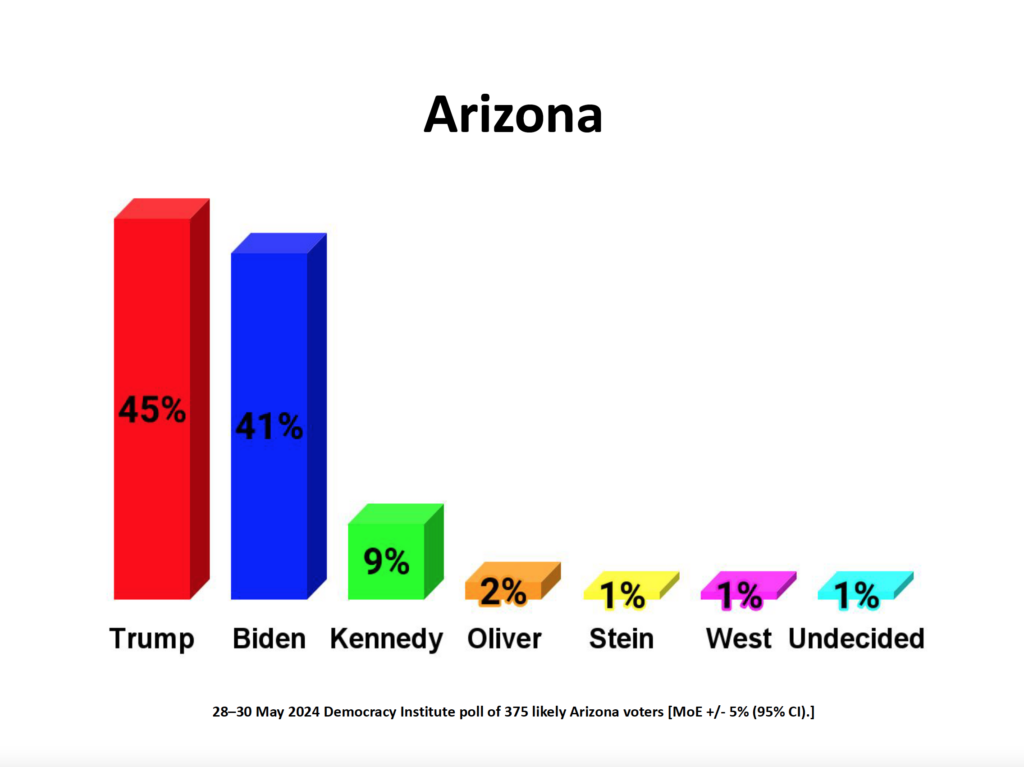
In practical terms, the Biden campaign has conceded Georgia and Nevada to Trump. The president’s campaign now focuses upon Arizona, Pennsylvania, Michigan, and Wisconsin. Biden’s path to an Electoral College majority is plausible but quite narrow in comparison to Trump’s path, which continues to widen. Given recent head-to-head polling in Minnesota, New Hampshire, and Virginia, the Trump campaign is expected to commit significant resources to flipping one or more of those previously reliably blue states.

Swing voters: For some time, Trump has polled well with those who voted in 2020. He is running even with, and sometimes slightly ahead of, Biden among these voters. Trump’s effort is aided further by the fact the voters who most likely will decide his electoral fate are the new voters, the (to-date) nonvoters, and the low-propensity-to-vote who mostly could not or did not vote in 2020.
This new, crucial swing voter group is overwhelmingly young and working class. It is mostly, but not exclusively, male, and disproportionately black, Hispanic, and Asian. The majority did not attend college, many are unemployed, or at least underemployed, a significant number receive disability benefits, and lots of them derive their living from the shadow economy.
In Democracy Institute polling, Trump does especially well with this group, achieving double-digit leads over Biden. These Americans are convinced the country’s ruling class has rigged the economic system against ordinary people. Prior to Trump’s trial verdict, these voters were already the most likely to think Trump was being persecuted by the judicial system and the most likely to vote for him as a result.
It is highly probable they will be very sympathetic to Trump’s assertion that, although he is a convicted felon, he is not a corrupt or a guilty man. Furthermore, these voters are disproportionately located in key swing states (Arizona, Georgia, Michigan, Nevada, Pennsylvania, and Wisconsin). Should a significant number cast a ballot, it will be extremely difficult for Biden to secure an electoral college majority.

Issues: Voters’ issue priorities remain an enormous advantage to the Trump campaign. Trump’s criminal record is not a concern for most voters. Simply put, the “It’s the economy, stupid!” mantra popularized by James Carville, campaign manager for Bill Clinton’s 1992 victory, is deeply applicable to this year’s election. The economy issue category, which includes popular fears over inflation, jobs, taxes, government spending, and recession, continues to stand head and shoulders above other concerns.
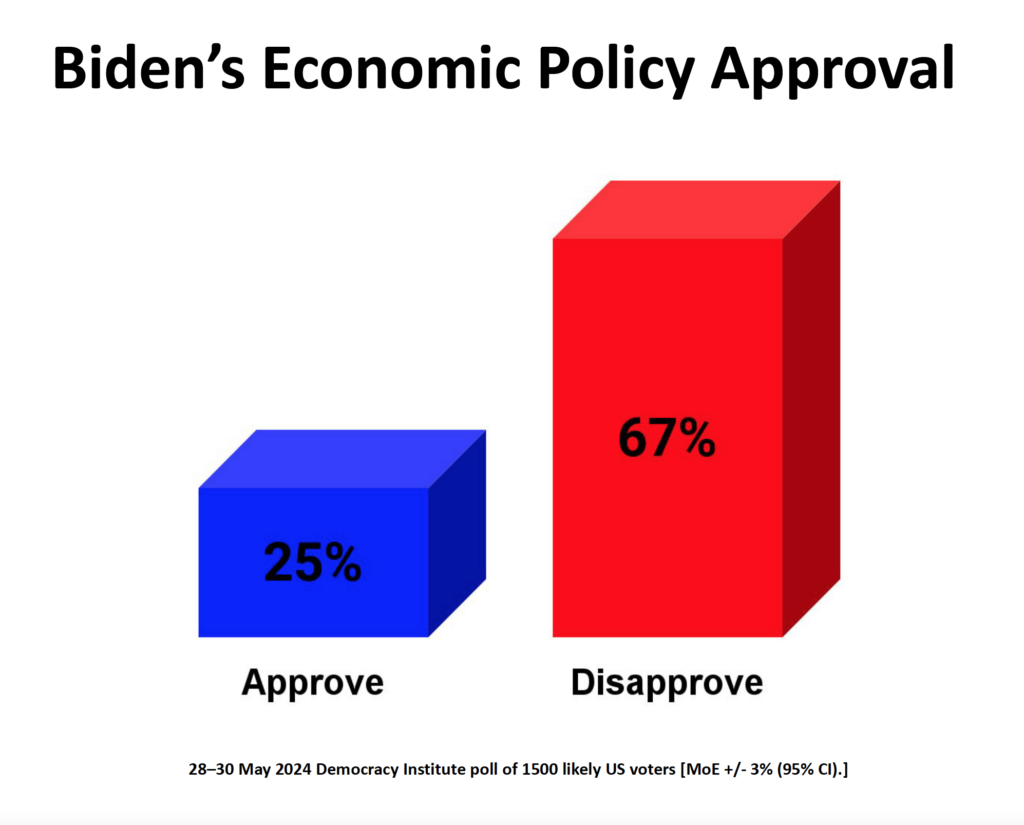
Most voters believe the economy is in recession. As of May 31, Gallup’s Economic Confidence Index is an unnerving -34. With many economic indicators trending downwards, and near-term economic forecasts becoming increasingly pessimistic, it is hard to see how pocketbook issues are not front-of-mind for most voters. Hence, Biden’s economic policy approval rating is an abysmal 26 percent.

It is therefore hardly surprising that a majority of voters say they were better off under Trump than they are under Biden.
Narrative: Trump’s jury trial changed his campaign’s overarching storyline. Until May 30, the narrative was the Biden-Trump rematch, which meant two old, not especially popular, candidates slugging it out over who was the better president and who was the more corrupt person. No longer. Going forward, for a majority of voters the election is a contest between Trump and The System, which clearly, crudely, and nakedly seeks his political demise.
Trump’s guilty verdict morphed a brash, uber-confident, charismatic celebrity New York billionaire, with a with a penchant for marrying models and a glamorous, gold-plated lifestyle, into a real-life victim. On the basis of his most recent focus group research, pollster Luntz is convinced Trump, if imprisoned, would become a martyr to his staunchest supporters.
The verdict has given birth to a new coalition of Trump Empathy Voters (TEV). They are racially and ethnically diverse Americans who care neither for Trump personally nor his political persona. Many TEV are political independents, new voters, low-propensity voters, and non-Trump Republicans.
However, these ordinary Americans increasingly empathize with his legal troubles and identify with his neverending battles with the powerful elites who dominate America’s political, corporate, media, and legal environments. For many voters, especially the young and minorities, Trump the Felon is far more relatable and much cooler after his conviction.
Fundraising: The procurement of funds is an obvious way the verdict demonstrably aided the Trump campaign. Both the Trump campaign and WinRed, the payment processor for Republican campaign donations, are now drowning in donations. The Trump campaign’s post-verdict fundraising shattered every applicable record.
On May 31, Trump’s campaign raised more money ($52.8 million) than Biden’s campaign raised ($51 million) during the entire month. In the first three days after the verdict, the Trump campaign raised more money (more than $200 million) than Biden has raised throughout his entire campaign. By June 3, $300 million had been donated to Trump’s campaign. It is noteworthy that $70 million of the first $200 million was from small individual donations, signalling tremendous voter interest and turnout potential.
Not only is the Trump campaign attracting huge numbers of individual donors (two million in May), a leading indicator of widespread voter support, but 25 percent of all May donors were first-time Trump donors. In a tangible demonstration of the campaign’s potential to expand the pool of potential Trump voters, 30 percent of post-verdict small donors are not only first-time Trump donors, but are first-time campaign donors, period.
The Biden campaign’s longstanding cash advantage, which for example saw them outspend Trump four-to-one in Pennsylvania, has evaporated and it is unlikely to return. Trump now will be competitive with Biden in broadcast and digital advertising dollars nationally and in the swing states. Crucially, the Trump campaign will have the requisite resources for an effective voter mobilization program.
Social media: As with donations, social media follows, likes, and reposts are an imprecise yet valuable measure of the interest in and the enthusiasm for a campaign. They reflect grassroots energy in a way that top-line head-to-head polling statistics do not. A little more than a day after the verdict, Trump took giant strides to increase his social media presence. The results were impressive.
On June 1, Trump joined TikTok, the enormously popular social media platform used by 170 million Americans, especially women and young Gen Z adults. The response was seismic. In the first 24 hours, Trump’s account gained three million followers. Trump currently has 5.3 million TikTok followers. To put these figures in perspective, Biden’s TikTok account, opened a few months ago, has 355,000 followers. Trump’s single video posting has been viewed over 60 million times. In contrast, Biden’s first video was viewed 10 million times with most Biden videos receiving around 100,000 views.
Available polling, fundraising, and social media data, interlaced with a newly one-sided campaign narrative, suggest Trump will electorally overcome the guilty verdict. Of course, with presidential debates, nominating conventions, and other events still to come, it is possible, if unlikely, these events turn the dynamics of the campaign unexpectedly in Biden’s favor.
Should Trump’s conviction eventually cause him to lose ground, his campaign could recalibrate its message and adopt the Edwin W. Edwards model. Widely considered corrupt, former governor Edwards came from behind to handily defeat David Duke, an ex-Ku Klux Klan Grand Wizard, in the 1991 Louisiana gubernatorial runoff. Edwards’ winning slogan candidly spoke to a choice between the lesser-of-two-evils: “Vote for the crook. It’s important.”

Leave a Reply